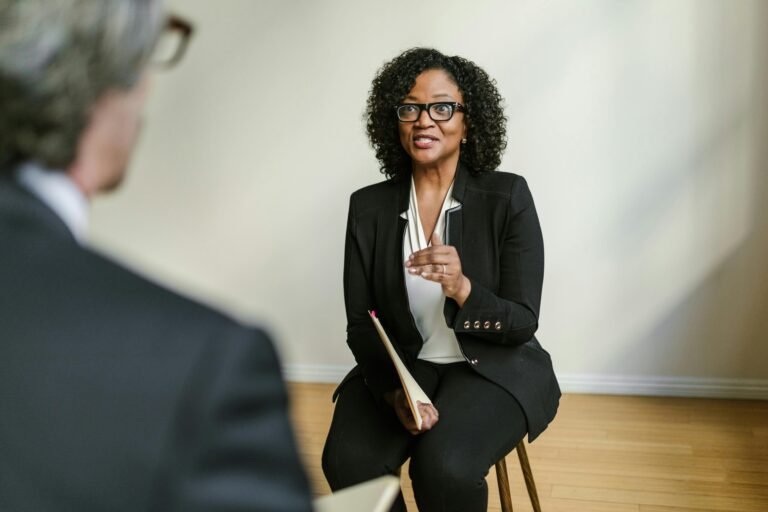The STAR (Situation, Task, Action, and Result) method is a powerful tool for answering behavioral questions presented in your school interview. It helps you structure your responses in a clear and effective way by focusing on the Situation, Task, Action, and Result. Below are several examples of how to use the STAR method to answer common behavioral questions in a K-12 instructional role interview.
These examples not only serve as a guide to framing your own experiences but also empowers you to highlight your strengths in a way that resonates with interviewers. By personalizing these examples with your own unique situations, tasks, actions, and results, you can effectively demonstrate your qualifications.
Interview Questions with Sample STAR Responses
Tell me about a time when you had to adapt your teaching style to a different group of students.
Sample Response:
- Situation: Last year, I was teaching English as a Second Language (ESL) to a group of adult learners with varying levels of proficiency.
- Task: My goal was to design lessons that were accessible and engaging for all students, despite their differing needs and learning styles.
- Action: I adapted my teaching style by using a variety of instructional methods such as visual aids, hands-on activities, and interactive group work to meet students’ needs. I also personalized the content, making it relevant to the students’ interests and backgrounds.
- Result: The students made measurable progress in their language skills and reported higher levels of engagement and motivation. I received positive feedback from both students and supervisors, which reinforced my ability to adjust my teaching methods to diverse learners.
Tell me about a time when you had to deal with a conflict or disagreement with a colleague.
Sample Response:
- Situation: Two months ago, I worked as a counselor at ABC Elementary School and had a disagreement with a colleague about how to handle a bullying case.
- Task: I needed to find a resolution to the disagreement and work together to ensure a fair and effective resolution for the students involved.
- Action: I used communication and conflict resolution skills to understand my colleague’s perspective, and I also explained my own viewpoint. After discussing our differing opinions, we brainstormed solutions that aligned with the school’s anti-bullying policies and best practices.
- Result: We resolved the conflict amicably, worked together to address the bullying issue, and restored a positive working relationship. This experience taught me how to handle workplace conflicts professionally while maintaining a focus on the well-being of students.
Tell me about a time when you had to use your critical thinking or problem-solving skills.
Sample Response:
- Situation: Last week, I was working as a librarian at DEF Middle School and encountered a malfunction with our library management system, preventing students from checking out books.
- Task: My goal was to resolve the issue promptly to minimize disruption to the library’s services, despite having limited technical support.
- Action: I utilized my problem-solving skills to troubleshoot the system. I identified the source of the problem as a corrupted database file and followed online tutorials to fix it. Additionally, I ensured the data was backed up before restoring the system to normal functionality.
- Result: The system was restored, allowing students to access the library’s resources again. The library operations returned to normal, and I learned new technical skills that I can apply in the future to prevent similar issues.
Tell me about a time when you had to demonstrate your leadership skills.
Sample Response:
- Situation: Last month, I was the head coach for the GHI High School soccer team, and we were preparing for an important regional tournament.
- Task: My role was to motivate and lead the team while helping them improve their skills in preparation for the tournament.
- Action: I created a training plan that included skill-building drills, teamwork exercises, and strategy discussions. I also held regular team meetings to foster camaraderie and address any concerns the players had.
- Result: The team’s performance improved significantly, both in skills and confidence. They finished in third place in the tournament, and the team spirit was stronger than ever. I gained invaluable experience in leadership and team management.
Tell me about a time when you had to show your creativity or innovation.
Sample Response:
- Situation: Last year, I was a science teacher at JKL Elementary School, and we had an upcoming science fair.
- Task: I was tasked with creating a project that would engage my students and demonstrate their learning in an innovative way, with limited time and resources.
- Action: I brainstormed creative project ideas and decided to focus on sustainability. I led the students in building solar-powered cars using recycled materials. I involved them in every step, from researching solar power to constructing the cars and testing them.
- Result: The project won first place at the science fair and was highly praised by the judges for its creativity and educational value. The students learned about renewable energy while also honing their problem-solving and teamwork skills. This project reinforced my ability to foster creativity and innovation in my students.
Tell me about a time when you had to handle a classroom disruption.
Sample Response:
- Situation: During a lesson on American history, a group of students in the back of the classroom started talking loudly and disturbing the rest of the class.
- Task: My responsibility was to address the disruption quickly without derailing the lesson or losing control of the classroom.
- Action: I calmly asked the disruptive students to step outside for a moment to have a brief discussion. I explained the impact of their behavior on the rest of the class and set clear expectations for behavior moving forward.
- Result: After the discussion, the students returned to class and focused on the lesson. The rest of the class continued without further disruption, and I learned how to address behavioral issues in a calm and constructive way.
Tell me about a time when you helped a student overcome a challenge.
Sample Response:
- Situation: A student in my math class was struggling with basic algebra concepts and was falling behind in class.
- Task: My task was to help the student catch up and build confidence in their math abilities.
- Action: I spent extra time after school providing one-on-one tutoring, breaking down difficult concepts into simpler steps. I also used visual aids and hands-on activities to help the student grasp the material.
- Result: The student’s grades improved significantly, and they gained more confidence in their ability to tackle difficult math problems. I learned the importance of providing personalized support to students in need.
Tell me about a time when you had to collaborate with others to achieve a goal.
Sample Response:
- Situation: Last semester, our school district introduced a new curriculum for teaching STEM subjects, and I was part of the implementation team.
- Task: My role was to collaborate with other teachers to ensure that the new curriculum was effectively integrated into the classroom.
- Action: I worked with colleagues to plan lessons, share resources, and exchange feedback on what worked well. We also held workshops to familiarize ourselves with the new curriculum and adjust our teaching methods.
- Result: The collaboration led to a smoother transition to the new curriculum, and student engagement in STEM subjects increased. I gained experience in working collaboratively and adapting to new instructional frameworks.
Tell me about a time when you had to motivate a reluctant learner.
Sample Response:
- Situation: I had a student in my English class who struggled with reading comprehension and was often disengaged during lessons.
- Task: My objective was to motivate the student to engage more with the material and develop a love for reading.
- Action: I worked with the student to identify topics that interested them, such as graphic novels and mystery stories. I also created personalized reading assignments and set small achievable goals to help build confidence.
- Result: The student’s attitude toward reading improved, and their performance on comprehension tests showed significant progress. I learned how to tailor my teaching to the individual needs of students and how to motivate reluctant learners.
Tell me about a time when you had to deal with a time-sensitive project.
Sample Response:
- Situation: During the end of the semester, I was tasked with organizing the school’s annual poetry contest, which was just weeks away.
- Task: My goal was to organize the event efficiently, ensuring that students had enough time to prepare while also meeting all administrative deadlines.
- Action: I created a detailed timeline, assigned responsibilities to other teachers, and communicated regularly with students to ensure they were on track. I also coordinated with the administration to secure resources and set up the venue.
- Result: The poetry contest was a success, with a high level of student participation and positive feedback from both students and parents. I learned how to manage time-sensitive projects while keeping everything organized and on schedule.
In Conclusion
The STAR method is an excellent tool for structuring your answers to behavioral questions, especially when interviewing for a and in instructional job in a K-12 or higher education school setting. By providing clear examples of how you’ve handled situations in the past, you can effectively showcase your skills, experience, and ability to solve problems. Use the examples above as a guide, but remember to tailor your responses to your unique experiences. By doing so, you’ll be well-prepared to impress interviewers and demonstrate why you’re the right candidate for the job.
We wish you the best of luck as you search or prepare for a new role!
Related Posts
How to Use the STAR Method to Answer Interview Questions
How to Conduct a Self-Assessment to Identify Your Strengths and Weaknesses
5 Tips for Answering Interview Questions You Don’t Know the Answer To
What to Say and What Not to Say About a Previous Employer
Why You Should Never Criticize a Former Employer During a Job Interview
How to Ace Your Next Interview by Recording Yourself









